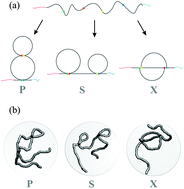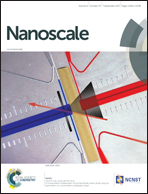Topology of polymer chains under nanoscale confinement†
Abstract
Spatial confinement limits the conformational space accessible to biomolecules but the implications for bimolecular topology are not yet known. Folded linear biopolymers can be seen as molecular circuits formed by intramolecular contacts. The pairwise arrangement of intra-chain contacts can be categorized as parallel, series or cross, and has been identified as a topological property. Using molecular dynamics simulations, we determine the contact order distributions and topological circuits of short semi-flexible linear and ring polymer chains with a persistence length of lp under a spherical confinement of radius Rc. At low values of lp/Rc, the entropy of the linear chain leads to the formation of independent contacts along the chain and accordingly, increases the fraction of series topology with respect to other topologies. However, at high lp/Rc, the fraction of cross and parallel topologies are enhanced in the chain topological circuits with cross becoming predominant. At an intermediate confining regime, we identify a critical value of lp/Rc, at which all topological states have equal probability. Confinement thus equalizes the probability of more complex cross and parallel topologies to the level of the more simple, non-cooperative series topology. Moreover, our topology analysis reveals distinct behaviours for ring- and linear polymers under weak confinement; however, we find no difference between ring- and linear polymers under strong confinement. Under weak confinement, ring polymers adopt parallel and series topologies with equal likelihood, while linear polymers show a higher tendency for series arrangement. The radial distribution analysis of the topology reveals a non-uniform effect of confinement on the topology of polymer chains, thereby imposing more pronounced effects on the core region than on the confinement surface. Additionally, our results reveal that over a wide range of confining radii, loops arranged in parallel and cross topologies have nearly the same contact orders. Such degeneracy implies that the kinetics and transition rates between the topological states cannot be solely explained by contact order. We expect these findings to be of general importance in understanding chaperone assisted protein folding, chromosome architecture, and the evolution of molecular folds.



 Please wait while we load your content...
Please wait while we load your content...